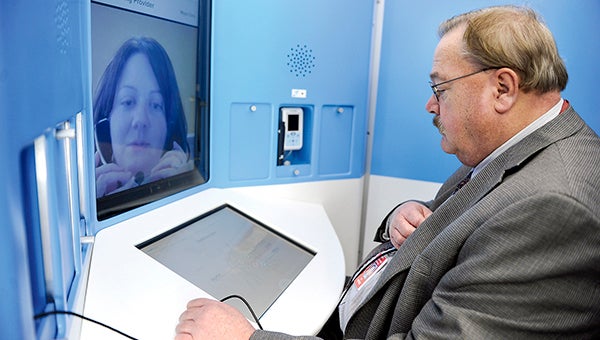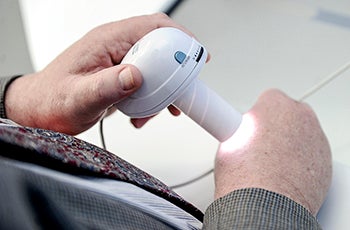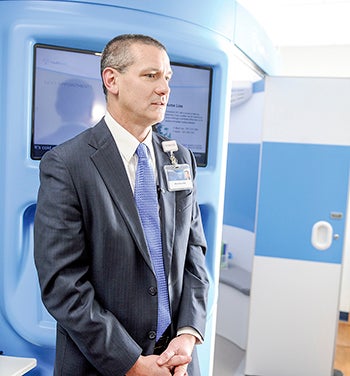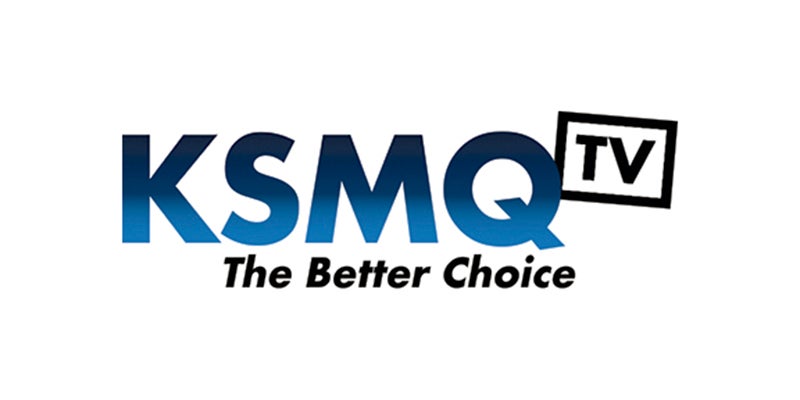District health hits the web; Health kiosks for school staff open Monday
Published 11:25 am Friday, February 27, 2015

Mayo nurse practitioner Heidi Stevermer consults with Superintendent David Krenz as the new Mayo Clinic Health Connection at Ellis Middle School is demonstrated Friday. — Eric Johnson/photodesk@austindailyherald.com
Austin Public Schools workers now have an easier, quicker, less expensive way to visit the doctor.
Two Mayo Clinic Health Connection kiosks at Ellis Middle School and the former Home Health Care and Hospice building, 408 Fourth Ave. NW, are ready to see their first patients Monday morning. The kiosks will be open 7 a.m. to 7 p.m. Monday through Friday and will have a Mayo staff member to sign in patients, help use the devices if needed and sterilize after use.
“We’ve enjoyed working with the school district and their leadership because we think they share our passion for this pilot project,” Mayo Austin and Albert Lea CEO Dr. Mark Ciota said at an open house Thursday.

Austin Public Schools Superintendent David Krenz uses a magnascope to look at his skin as he consults with Mayo nurse practitioner Heidi Stevermer using the Mayo Clinic Health Connection kiosk at Mayo Health Clinic Thursday afternoon.
“And obviously our geographical location is close to each other, and our similar desires to decrease the cost of health care while maintaining quality,” he added.
The school district announced the partnership with Mayo Clinic Health System in December with hopes to make access to medical services easier and more affordable through the use of Mayo Clinic Health Connection, a kiosk that allows patients to be treated for basic care via teleconference through the HealthSpot platform.
“This is a pilot so both entities want to learn from it and see what we can decipher as far as the best way to deliver this type of health care,” Ciota said. “And should it be successful, then we’d either hope to expand more at the school district or get other business partners.”
A health provider — who can be anywhere with a laptop and the Internet — will see patients inside the private, walk-in kiosk that provides high-definition videoconferencing and interactive, digital medical devices. District staff and Mayo Clinic Health System staff, as well as their dependents can visit any of the three kiosks. Along with the Ellis and Fourth Avenue Northwest kiosks, a third kiosk has been on the second floor of the medical center since last fall. The patients can visit the kiosks without scheduling an appointment to be treated for minor, common health conditions, such as colds, earaches, sore throats, sinus infections, upper respiratory infections, rashes and skin conditions, and eye conditions.
Ciota said one main goal is to keep costs for healthcare down, and visiting the kiosk is much less expensive than going to the emergency room or visiting the doctor. Superintendent David Krenz was happy to show how the kiosk worked Thursday.
“It’s exciting because it is an opportunity to move forward in terms of providing a service for our staff and their families,” Krenz said. “And it is something we can pilot, we can work out the bugs, and hopefully eventually look at it again maybe in a bigger sense for all of our students and their families.”
Krenz noted school staff is eager to try the new kiosk.
“A lot of the staff are excited and they are ready to get going, so it’ll be a nice experience,” he said. “Now, will there be 100 percent usage to begin with, I’m sure not, but it’s one of those things that people will use and positive word will spread and more and more people will use it.”
Benefits specialist Elaine Hansen also made note of the staff’s excitement.

Mayo Health Clinic Systems — Albert Lea and Austin CEO Dr. Mark Ciota talks about the new partnership with Austin Schools District.
“They’re anxious for this to be up,” she said. “They’re seeing this as a really great opportunity and not just the people here at the Ellis building but the people across the district.”
“The bottom line is it’s going to save them time and money, so it’s a win for everybody,” she added.
The kiosk takes height, weight, blood pressure and temperature, and comes equipped with a magnascope to look at eyes, throat and skin, an otoscope to look at the ear and ear drum, a pulse oximeter which takes oxygen levels, and a stethoscope to check heart and lung readings.
The district chose to place the kiosks in Ellis and the former Hospice building for good availability to every staff member.
“Health care is a critical issue for not only the people who work at the district but also our families who attend the schools,” Krenz said. “And if we could provide that service to provide more time in school and more time in instruction, then more learning will go on.”
Clinic officials first started discussing the HealthSpot idea about a year ago when an administrator saw the unit at a conference. Administrators say such kiosks could eventually be used at workplaces to provide easy access to healthcare, and it could help businesses keep healthcare costs down. Krenz said the partnership with Mayo Public Health Systems has been good.
“As we looked at this, Mayo Public Health Systems really stepped up to look outside of their traditional delivery of services to find something that would meet our needs,” he said. “And I think that’s critical to understand is that we’ve got partnerships that are willing to go the extra mile in our community.”





